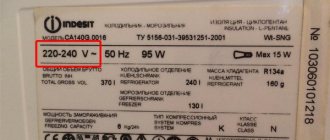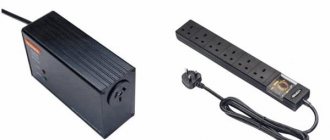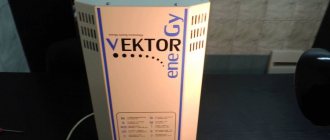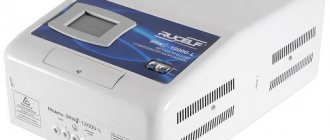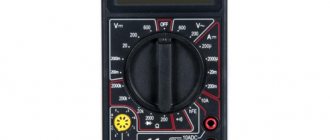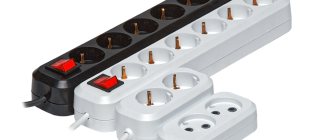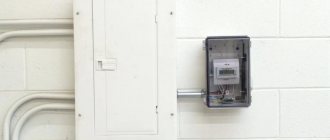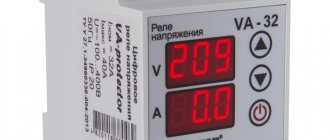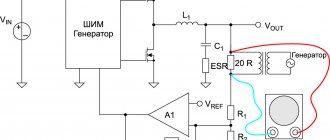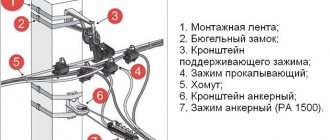Thanks to voltage stabilizers, the operation of which usually remains unnoticed by people, you can get rid of such unpleasant things as the failure of household appliances and unplanned expenses. When choosing this device, the specifics of the electrification of the building in which it is planned to be used are taken into account, first of all. The most popular household stabilizers are electromechanical (also called servo-drive) and relay. Representatives of each type have their own characteristics, advantages and disadvantages. In today's article we will tell you Which voltage stabilizer is better - relay or electromechanical, consider the main selection criteria and the best models.
Calculator for calculating the power of a voltage stabilizer for a home
Go to calculations
| Photo | Name | Rating | Price | |||
| Hybrid stabilizers | ||||||
| #1 | Hybrid SNVT-6000/3 | ⭐ 5 / 5 | Find out the price | |||
| TOP 2 electromechanical stabilizers | ||||||
| #1 | RUCELF SDW II-12000-L | ⭐ 5 / 5 1 - voice | Find out the price | |||
| #2 | RESANTA ACH-10000/1-EM | ⭐ 4.9 / 5 | Find out the price | |||
| TOP-2 relay devices for 12 kW | ||||||
| #1 | RUCELF SRF II-12000-L | ⭐ 4.95 / 5 | Find out the price | |||
| #2 | Wester STB-10000 | ⭐ 4.9 / 5 | Find out the price | |||
| TOP 3 relay devices up to 5 kW | ||||||
| #1 | Wester STB-5000 | ⭐ 4.95 / 5 | Find out the price | |||
| #2 | RUCELF SRWII-6000-L | ⭐ 4.85 / 5 | Find out the price | |||
| #3 | RESANTA ACH-5000/1-C | ⭐ 4.8 / 5 | Find out the price | |||
| TOP 3 relay devices up to 1 kW | ||||||
| #1 | RESANTA LUX ASN-1000N/1-C | ⭐ 5 / 5 | Find out the price | |||
| #2 | Wester STB-1000 | ⭐ 4.8 / 5 1 - voice | Find out the price | |||
| #3 | Quattro Elementi Stabilia 1000 | ⭐ 4.6 / 5 | Find out the price | |||
Which stabilizer would you choose or recommend?
Take the survey
Relay stabilizers
Such devices are distinguished by their simple design and low prices. In general, they consist of 3 main elements:
- fee . Intended for measuring input current, determining exactly how much voltage needs to be added at the output;
- relay _ Needed to switch between windings;
- transformer _ This element has several windings - usually there are 4, but there are models with 9.
On a note! One of the main features is that the output current changes in steps. Due to the fixed number of windings, the output current is only normalized to certain values. If the device, for example, has 4 windings, then the addition will be carried out in steps of 20-25 V. If there are more windings, then the stabilization will be more accurate, but the device will respond more slowly in case of signal distortion.
If the signal drops below the level that the stabilizer can handle, the power is cut off. If the signal value becomes acceptable again, the operation of the device resumes. This may be accompanied by negative transients.
pros
- affordable price;
- large spread of permissible signal values;
- compactness;
- fairly low sensitivity to various signal distortions and overloads;
- possibility of operation at temperatures from -40 to +40 degrees;
- prolonged work under overload conditions.
Minuses
- the relay is sensitive to various contaminants;
- stabilization occurs in stages;
- the device operates quite noisily (especially if voltage surges occur frequently);
- reacts quite slowly.
If you follow all operating rules, such a stabilizer can last more than 10 years. But for high-precision devices for which voltage quality is important, it is better not to use it. But for ordinary household appliances it’s a pretty good option.
Video - Operating principle of a relay type stabilizer
As it was before
Once upon a time, laboratory autotransformers with manual regulation were common to regulate the voltage on the load.
These were the simplest devices in design and principle of operation. Regulation was carried out by moving the carbon brush-current collector along the turns of the toroidal winding of the autotransformer, which changed the transformation ratio and output voltage, allowing you to set the desired value, including the nominal mains 220 V.
The number of turns of the winding connected to the network did not change.
When the network voltage is low, the autotransformer operates in a step-up mode, and when the network voltage is high, it operates in a step-down mode. When the network voltage corresponds to the nominal value, the carbon brush is installed exactly on the winding turn connected to the network, and voltage conversion does not occur.
The only drawback in this case is that in addition to the useful load current, the no-load current of the autotransformer is uselessly consumed from the network.
And everything would be fine, but there was always a danger that with the next increase or decrease in the mains voltage, the person carrying out the regulation would not notice this, and the voltage at the load would change accordingly.
TOP 3 relay devices up to 1 kW
This includes the cheapest and simplest models, characterized by maintainability and reliable operation. Another feature is that a characteristic clicking sound is produced during operation.
3No3. Quattro Elementi Stabilia 1000
An Italian-made device that can cope with the most serious power surges in domestic conditions - from 140 V to 270 V. There are, of course, models with much higher power, but this device is still very popular in Russia. As a rule, they buy it for computer equipment. The efficiency of the model is quite high – it reaches 98 percent. Provides protection against power surges, overheating, and damage due to short circuits. The model is inexpensive, compact, weighs only 2.7 kg.
pros
- 3-stage protection;
- excellent efficiency;
- low cost;
- compactness, light weight.
Minuses
- power restrictions.
Prices for Quattro Elementi Stabilia 1000
Quattro Elementi Stabilia 1000
Video - Review of Quattro Elementi Stabilia 1000
2No2. Wester STB-1000
Compact floor-standing device, characterized by quiet operation and ease of use. Works with a wide voltage range - 140-260 V (the device has an error of 8 percent). Reliable protection of household appliances from power surges, overheating and short circuits is provided. There is a digital display that displays all the necessary information. Air cooling. It is permissible to use the device at temperatures from 0 to +40 degrees. The model operates silently and provides good stabilization. But it costs even more than the leader of this rating.
pros
- noiselessness;
- excellent voltage stabilization;
- short circuit protection;
- no heating during operation.
Minuses
- The light blinks and clicks when the relay is activated.
Reviews and prices for Wester STB-1000
1No1. RESANTA LUX ASN-1000N/1-C
The leader of our rating is a popular model, characterized by good active power (1 kW) and an extremely simple design. This Latvian stabilizer operates with voltage within 140-260 V, and provides protection against interference and overheating. The error is small (also 8 percent), and it does not confuse buyers who most often purchase this device for household use.
pros
- high-quality stabilization of voltage drops;
- high build quality;
- affordable price;
- presence of 2 sockets;
- reliability.
Minuses
- There may be a plastic smell at first.
Prices for RESANTA LUX ASN-1000N/1-C
RESANTA LUX ASN-1000N/1-C
Ferroresonant
Ferroresonance stabilizers operate on the principle of electromagnetic oscillations that occur in the transformer and inductance circuit. As a result, they are absolutely not afraid of various interferences that can be created by operating equipment.
The principle of their operation is based on stabilization by saturating iron, which is unable to transmit magnetic flux to the output coil from the input coil. In addition, an additional coil is installed, which is responsible for damping the magnetic flux in the core depending on the load. Thanks to the capacitor used in the system, the most accurate leveling of the output power is achieved.
High reliability and efficiency lead to the fact that these models are used in almost any conditions to stabilize voltage over an extremely wide range. Such devices also compare favorably in their cost.
Main disadvantages:
- High noise level.
- The quality of stabilization directly depends on the load size.
- To date, the response rate is insufficient.
TOP 3 relay devices up to 5 kW
Such devices are used to protect PCs, refrigerators, etc. Let's get acquainted with the most successful models.
3No3. RESANTA ACH-5000/1-C
A powerful Latvian-made device that stabilizes voltage in the range of 140-260 V. We also note that the model is a floor-standing type, capable of operating at a current frequency of up to 60 Hz. Excellent protection against voltage surges, various interferences and short circuits. With an 8 percent error, it responds in just 7 ms. Cooling is natural. The device weighs 13 kg.
pros
- high build quality;
- fairly low cost;
- great power.
Minuses
- At first there is a plastic smell;
- The handles are quite small.
Prices for RESANTA ACH-5000/1-C
RESANTA ACH-5000/1-C
2No2. RUCELF SRWII-6000-L
The peculiarity of this effective wall-mounted device is its high efficiency (equal to 98 percent), wide operating range (from 95 V to 280 V) and, of course, very accurate stabilization. The model is equipped with a microprocessor that controls all work; a wide display allows you to track all readings. Cooling is natural. The device operates quickly enough, does not click loudly, and looks quite attractive.
pros
- works quietly;
- excellent power;
- wide operating range;
- wide display.
Minuses
- quite high cost.
Reviews and prices for RUCELF SRWII-6000-L
1No1. Wester STB-5000
This model is considered the most reliable and has the longest service life in its category. The power, of course, is not a record (4 kW to be specific), but the device is able to cope with changes from 140 V to 260 V for quite a long time. Forced cooling reliably protects against overheating. Light weight (only 10.7 kg), compact dimensions. The model is easy to use, all characteristics correspond to the declared ones.
pros
- low noise performance;
- high build quality;
- forced cooling system;
- ease.
Minuses
- If the temperature drops below zero, the device's performance deteriorates.
Prices for Wester STB-5000
Single-phase voltage stabilizer Wester STB-5000 (4 kW)
Flaws
When switching frequently, power relays fail
One of the most significant disadvantages of relay stabilizers, in my opinion, is the possibility of failure of power relays if mode switching occurs quite often and intensively. Contacts oxidize over time or can burn at high currents, which greatly reduces the service life of the relay.
Clicking when switching relays
Another feature that can become a serious drawback if the relay stabilizer is installed somewhere near you is the sound of the relay switching, which clicks quite loudly.
Relatively high stabilization error, on average about 5-8%
Depending on the number of taps from the autotransformer - secondary windings and, accordingly, the number of relays in the circuit, the relay stabilizer has a degree of stabilization error, on average 5-8%, and this is quite a lot. As you can see from the calculations presented above, the stages at which stabilization occurs are within 15 Volts, which is equal to 6.8% of 220V; particularly sensitive electrical appliances can react to such indicators.
If you require normalization with greater accuracy, be sure to consider electromechanical voltage stabilizers.
Short-term interruption of current supply at the moment of relay switching
When switching a relay, during a change of modes, for a very short time, the current supply is interrupted when the contacts of one relay are already broken, and the second is just closing. In this case, a surge or voltage surge often occurs. This can have a negative effect on particularly sensitive electronic components and can also be reflected, for example, in a short-term change in the brightness of the lamps.
Power drop at low voltage
Relay stabilizers produce the full power declared by the manufacturer only in a fairly narrow range of incoming voltages, often only up to 190 Volts, then the performance rapidly drops and at some point reaches only 40-50% of the nominal.
TOP-2 relay devices for 12 kW
Such stabilizers are characterized by the fact that they are used not only in private homes, but also in workshops and office spaces. Let's look at the best models, according to experts.
2No2. Wester STB-10000
A high-quality device that operates very quietly. Not the most “sophisticated” and powerful, but still took its place in the ranking (mainly thanks to numerous reviews). With an active power of only 8 kW, the device has such advantages as low weight (17.6 kg) and compactness. For the average home - an ideal option. The display is large and informative; users also note the high-quality cooling system.
pros
- high build quality;
- compactness, light weight;
- very informative screen;
- high-quality cooling system.
Minuses
- power is not the highest.
Reviews and prices for Wester STB-10000
1No1. RUCELF SRFII-12000-L
The advantages of this model are high accuracy (in this case the error is only 3.5 percent) and excellent power (10 kW). Can be used for stabilization in single-phase networks. Floor-standing design, with forced cooling. The wires are connected using terminals; it is possible to connect equipment that does not require stabilization. The informative LCD display shows all the necessary information about voltage and errors that have occurred during operation.
pros
- Ease of use;
- good power;
- stabilization accuracy;
- informative liquid crystal display.
Minuses
- The device is quite noisy.
Prices for RUCELF SRF II-12000-L
RUCELF SRF II-12000-L
Electromechanical stabilizers
In them, the input voltage is stabilized due to 2 main components, namely:
- boards;
- electric motor.
When the voltage changes, the current-collecting parts begin to move along the transformer windings, due to which the value is adjusted to the required value.
pros
- affordable price;
- smooth stabilization;
- accuracy.
Minuses
- large dimensions;
- low reaction speed;
- noisy operation;
- poor wear resistance;
- Current collecting brushes made of graphite need to be changed.
Note! As we see, such devices have very high accuracy, but maintenance is required regularly. The design has moving parts, which explains the noise of operation (therefore it is better to install the stabilizer in some technical room). As for the mentioned brushes, they generate a stream of sparks, and therefore the devices are not recommended to be installed where gas is used.
Video - Electromechanical stabilizers
Smooth adjustment
It can also be useful if something ultra-precise and thin is connected to the stabilizer, such as sensors in a laboratory or other measuring instruments. Household appliances usually do not need this, and a quick (even abrupt) voltage equalization for them is better than a smooth decrease/increase.
Presence of moving parts
This leads to the fact that the voltage stabilizer will need periodic (approximately once a year) maintenance.
During operation, dust gets inside the housing, which settles on the current-collecting brushes, causing the open contact to spark, introducing interference into the output circuit. Therefore, brushes must be changed.
It is strictly forbidden to use electromechanical voltage stabilizers in rooms with gas equipment! A spark from the pantograph may cause a gas fire!
Noisiness
Electromechanical stabilizers are due to their very design and can certainly cause inconvenience to users, especially at night.
It is worth noting, however, that modern devices are largely free of this drawback, partly due to the use of modern materials, partly due to the sound insulation of the body of the stabilizer itself
However, it is worth noting the rule - more power - more noise the rectifier produces
Low efficiency
The result of using mechanics. On the one hand, this indicator is not so bad, but on the other, when choosing between a relay (from 99.2%) and an electromechanical (from 97-98%) stabilizer, it can become decisive, because saving electricity in the current realities is a very relevant factor.
Response speed
This type of stabilizer has the lowest. And this is one of its main shortcomings.
This figure is approximately 10 volts per second, which is 5 times lower than that of relay and 25 times lower than that of electronic.
In other words, if there is a voltage drop of 50 volts, then the electromechanical stabilizer will need as much as 5 seconds to equalize the current. It is too long.
As you can see, all the advantages of the electromechanical stabilizer are more than canceled out by its shortcomings.
Cheapness, smoothness and accuracy are not so attractive, given that this device will need to be disassembled and parts replaced at least once a year
TOP 2 electromechanical stabilizers
Due to their affordable cost and high accuracy, such models are very popular. Even if they are not the most reliable. Let us consider, as an example, the 2 most common devices.
2No2. RESANTA ACH-10000/1-EM
Floor-standing model with active power up to 10 kW, having good accuracy (2 percent) and good efficiency (97 percent). It is inexpensive, which is another advantage. The response is quite fast (10 ms), and the manufacturer also provides Bypass (special transit mode). The voltage stabilizes quickly and smoothly. The device looks stylish and does not make much noise during operation.
pros
- ease of installation/use;
- fast response;
- low cost;
- attractive appearance.
Minuses
- 50 A machines become unusable after some time.
Reviews and prices for RESANTA ACH-10000/1-EM
1No1. RUCELF SDW II-12000-L
The device is capable of providing maximum protection, and therefore is often used in cottages and private homes. With a power of 10 kW, the device perfectly protects the most powerful electrical equipment. Stabilization is very good (only 1.5 percent). Mounts on the wall, model weight – 27.5 kg. It is also worth noting the high efficiency - it is 98 percent. Active 4-level protection, Bypass mode provided.
pros
- Bypass operating mode is provided;
- excellent power;
- accuracy;
- maximum efficiency.
Minuses
- no significant deficiencies were identified.
Prices for RUCELF SDW II-12000-L
Single-phase voltage stabilizer RUCELF SDWII-12000-L
Video - Review of RUCELF SDW II-12000-L
Advantages
Low cost
It is due to their low price, relative to other types of stabilizers, that relay models are so popular. At the same time, in other respects, they completely cover the needs of the modern consumer in most cases.
Quite fast stabilization speed, on average 5-30 ms
Relay stabilizers react to changes in incoming voltage at high speed, and allow you to protect your electrical equipment even during sudden drops or surges
Simplicity and maintainability
Possessing a simple, understandable architecture, relay stabilizers do not have a mass of complex components that could fail. There are not many possible problems and all of them have been studied and described, are easily diagnosed and can be corrected at home, even if you have only superficial knowledge and skills in electrical repair.
What to choose? Compare electromechanical and relay devices
Let's get acquainted with the key parameters of both types of stabilizers and compare them. This will make it easier for you to decide which device is better.
Table. Comparison of main characteristics.
| Characteristic | Electromechanical | Relay |
| Characteristic | Electromechanical | Relay |
| Price | Medium/low | Low |
| Regulation | Smooth | Stepped |
| Dimensions | Large | Small |
| Accuracy | No more than 3 percent | No more than 7-8 percent |
| Reliability | Regular maintenance required | High |
| Speed | Not lower than 8 ms | About 40ms |
| Efficiency | 97 to 98 percent | Average – 99.2 percent |
As you can see, both varieties have their strengths and weaknesses, features, and characteristics. Therefore, it is necessary to choose one or another type individually in each specific case. Or, alternatively, resort to an alternative. What is this alternative?
Own power consumption
It is quite obvious that both stabilizers will themselves consume energy to ensure their operation.
The classic stabilizer consumes energy for 3 relays, an indication and a controller. The total current is about 100mA at a voltage of 12V (3 relays: 30mA x3 = 90mA). Taking into account losses on the power supply (multiply by 3), in the worst case we have 3.6 W. This is true for models up to 1000VA. Stabilizers from 4500VA to 40000VA have a power consumption of 15 - 20W.
The own power of inverter stabilizers depends on the total power of a particular model. For 350VA models it is 25W, for 3500VA it is 40W, for 12000VA it is 75W, for 13500 it is already 150W, etc.
A simple calculation shows that an inverter stabilizer with a power of 350 VA will “eat up” energy worth more than 1000 rubles per year, 12000 VA will consume more than 3,000 rubles, and 13,500 VA, respectively, will consume 2 times more energy, i.e. more than 6000 rubles.
For classic, even powerful models, these costs will not exceed 1000 rubles per year.
Alternative option. Hybrid stabilizers
In such devices, electricity is stabilized in two ways at once: relay converters are combined with an electromechanical design . If the second cannot supply 220 V, then the relay is activated. Experts note only one development, let’s take a look at it.
1No1. Hybrid SNVT-6000/3
Domestic model), which can be connected to the power network. That is why the device has a very wide scope of application - from private homes to industrial facilities. High accuracy is combined with the absence of EM waves during operation that can interfere with other equipment. An excellent option for medical institutions and offices.
pros
- 3-phase voltage;
- power reaches 6 kW;
- high efficiency (98 percent);
- precise (3 percent) stabilization.
Minuses
- quite high cost.
Reviews and prices for Hybrid SNVT-6000/3
Expert opinion: Afanasyev E.V.
Chief editor of the Stroyday.ru project. Engineer.
Do you know how to choose a voltage stabilizer for a gas boiler? I have prepared a detailed article on this topic.
Voltage maintenance accuracy and rated output voltage
These two important characteristics actually show the same thing, stabilization accuracy, so they are combined into one common point. As you understand, this characteristic is very important and shows how accurately the stabilizer corrects the incoming voltage.
So, for example, a mechanical stabilizer with an accuracy of 2%, in normal operation, will produce a voltage in the range from 216 to 224 Volts, and this is a very good indicator, even the most sensitive devices will not notice such voltage changes, for most of them these are set by the manufacturer normal operating modes.
At the same time, the relay stabilizer, with its 8% accuracy, will produce an output voltage in the range from 202 to 238 Volts, but this is a significant difference; not every device will operate normally at this voltage.
Thus, in terms of stabilization accuracy, a mechanical stabilizer unconditionally outperforms a relay one.
The main secrets of choosing a stabilizer
When choosing a suitable device, consider the following important parameters.
- Variety . In addition to those described above, there are also electronic stabilizers. Moreover, all varieties have their own limitations. Be sure to find out about them before visiting the store.
- Noisiness . Together with a gas boiler or, say, a refrigerator, the stabilizer must work around the clock. And if it is located near the bedroom or nursery, then silent operation becomes one of the main selection criteria.
- Load . This value must be calculated in advance. Sum up the power of all electrical appliances that are sensitive to power surges, add a small margin (about 20 percent). For example, to protect a TV and PC, a stabilizer with a power of 500 V to 1000 V is enough.
- Dimensions, weight . Of course, stabilizers are stationary devices, but if the chosen model is heavy and bulky, this will cause a lot of trouble. And if you can’t hide the device behind a curtain, then you should buy an attractive model that matches the interior.
- Efficiency . This indicator is also very important, since the device will consume electricity. The higher the coefficient, the smaller the energy losses will be and the better the work of the stabilizer will be.
